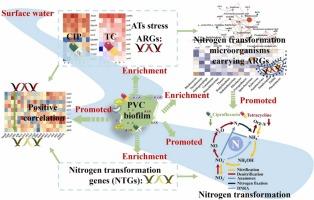微塑料生物膜可以形成富含抗生素抗性基因的微生物群落,促进抗生素胁迫下的氮转化
IF 11.3
1区 环境科学与生态学
Q1 ENGINEERING, ENVIRONMENTAL
引用次数: 0
摘要
地表水中抗生素胁迫下氮转化对微塑料生物膜的响应以及功能基因与微生物之间的相互关系尚不清楚,需要进一步研究。本研究通过分析各种氮形态的变化来研究氮转化的响应,并探讨在ATs(环丙沙星(CIP)和四环素(TC))和PVC生物膜下氮转化功能与抗生素抗性基因(ARGs)的相互作用。与对照组相比,暴露于成熟的聚氯乙烯(PVC)生物膜使硝酸盐氮(NO3——N)和氨氮(NH4+-N)的去除率分别提高了12.48%和8.79%,NO3 -N的去除率常数达到0.17。然而,共暴露在CIP环境中会显著抑制氮的转化,将NO3 -N的去除速率常数降低到0.08。在PVC生物膜中,氮转化更活跃,ARGs水平转移增强,导致氮转化基因(NTGs)与ARGs之间的正相关更强。携带NTGs的微生物在很大程度上与ARGs宿主物种重叠,包括食氢菌(Hydrogenophaga)、红球菌(Rhodococcus)和伊格纳维菌(Ignavibacterium),这两种基因类型都表现出高丰度。说明PVC生物膜通过富集携带高ARGs丰度的氮转化微生物,促进了ATs胁迫下的氮转化。这些结果拓展了对ATs和微塑料(MPs)对地表水氮转化影响的认识,并为微塑料生物膜独特的生态效应提供了理论支持。本文章由计算机程序翻译,如有差异,请以英文原文为准。

Microplastic biofilm may shape microbial community enriched with antibiotic resistance genes to enhance nitrogen transformation under antibiotic stress
The response of nitrogen transformation to microplastic biofilm under antibiotics (ATs) stress as well as the interrelationships between functional genes and microorganisms in surface water are not very well understood and need further investigation. This study investigated the response of nitrogen transformation by analyzing changes in various nitrogen forms and explored the interaction between nitrogen transformation functions and antibiotic resistance genes (ARGs) under exposure to ATs (ciprofloxacin (CIP) and tetracycline (TC)) and PVC biofilm. Compared to the control, exposure to mature polyvinyl chloride (PVC) biofilm increased nitrate nitrogen (NO3--N) and ammonia nitrogen (NH4+-N) removal by 12.48% and 8.79%, with the NO3⁻-N removal rate constant reaching 0.17. However, co-exposure to CIP significantly inhibited nitrogen transformation, reducing the NO3⁻-N removal rate constant to 0.08. In PVC biofilm, more active nitrogen transformation and enhanced horizontal transfer of ARGs led to a stronger positive correlation between nitrogen transformation genes (NTGs) and ARGs. Microorganisms carrying NTGs largely overlapped with ARGs host species, including Hydrogenophaga, Rhodococcus, and Ignavibacterium, which exhibited high abundance of both gene types. This indicated that PVC biofilm facilitated nitrogen transformation under ATs stress by enriching nitrogen transformation microorganisms carrying high ARGs abundance. These results extended knowledge of effects of ATs and microplastics (MPs) on nitrogen transformation in surface water and provided theoretical support for unique ecological effects of microplastic biofilm.
求助全文
通过发布文献求助,成功后即可免费获取论文全文。
去求助
来源期刊

Journal of Hazardous Materials
工程技术-工程:环境
CiteScore
25.40
自引率
5.90%
发文量
3059
审稿时长
58 days
期刊介绍:
The Journal of Hazardous Materials serves as a global platform for promoting cutting-edge research in the field of Environmental Science and Engineering. Our publication features a wide range of articles, including full-length research papers, review articles, and perspectives, with the aim of enhancing our understanding of the dangers and risks associated with various materials concerning public health and the environment. It is important to note that the term "environmental contaminants" refers specifically to substances that pose hazardous effects through contamination, while excluding those that do not have such impacts on the environment or human health. Moreover, we emphasize the distinction between wastes and hazardous materials in order to provide further clarity on the scope of the journal. We have a keen interest in exploring specific compounds and microbial agents that have adverse effects on the environment.
 求助内容:
求助内容: 应助结果提醒方式:
应助结果提醒方式:


